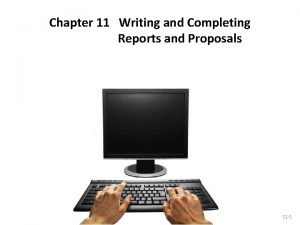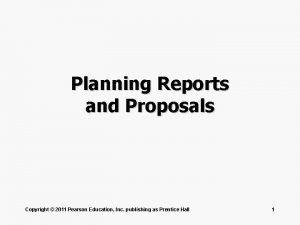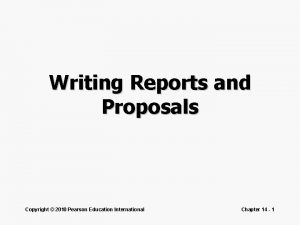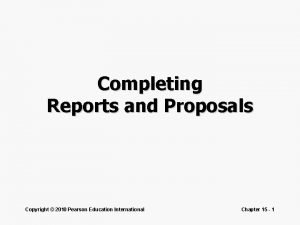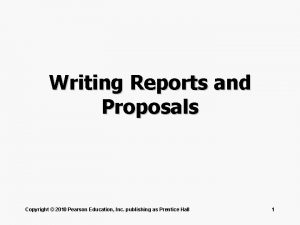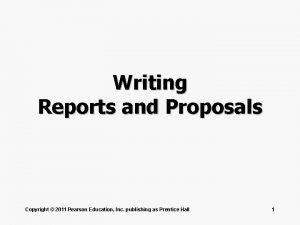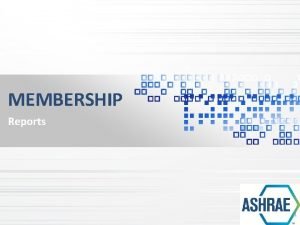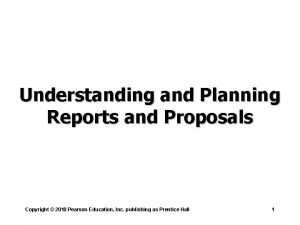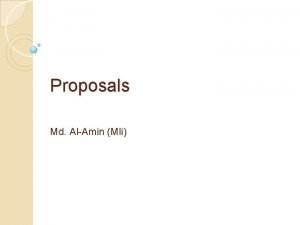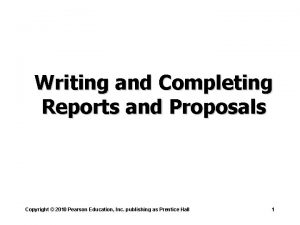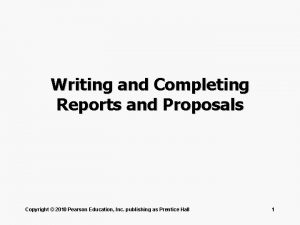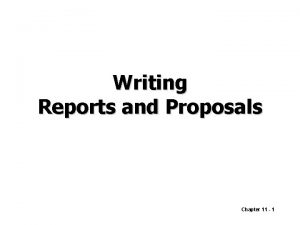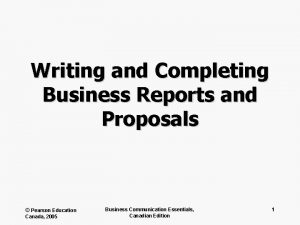Planning Reports and Proposals Copyright 2010 Pearson Education



























- Slides: 27

Planning Reports and Proposals Copyright © 2010 Pearson Education, Inc. publishing as Prentice Hall 1

Learning Objectives • Adapt the three-step writing process to reports and proposals • Explain the value of a work plan in the development of long reports • List the key elements of a business plan Copyright © 2010 Pearson Education, Inc. publishing as Prentice Hall 2

Learning Objectives • Identify three steps you can take to ensure effective organization of online reports and other website content • Discuss three major ways to organize analytical reports • Explain how to choose an organizational strategy when writing a proposal Copyright © 2010 Pearson Education, Inc. publishing as Prentice Hall 3

Effective Reports and Proposals • Informational reports • Analytical reports • Proposals Copyright © 2010 Pearson Education, Inc. publishing as Prentice Hall 4

The Three-Step Process Planning Analyze Situation Gather Information Select Medium Get Organized Writing Adapt to the Audience Compose the Message Copyright © 2010 Pearson Education, Inc. publishing as Prentice Hall Completing Revise Produce Message Proofread Message Distribute Message 5

Analyzing the Situation • Define purpose • Create work plan – To inform – Determine tasks – To identify – Create outline – To analyze – Set schedule Copyright © 2010 Pearson Education, Inc. publishing as Prentice Hall 6

Define Your Purpose • Informational – Audience needs – Audience expectations • Analytical – Perceived problem – Perceived opportunity Copyright © 2010 Pearson Education, Inc. publishing as Prentice Hall 7

Prepare the Work Plan • Problem, opportunity, purpose, and scope – Tasks to be accomplished – Final products or outcomes – Schedules and requirements – Plans for following up – Working outline Copyright © 2010 Pearson Education, Inc. publishing as Prentice Hall 8

Gather the Information • Purpose • Audience • Priorities Copyright © 2010 Pearson Education, Inc. publishing as Prentice Hall 9

Select the Medium • Media requirements • Media preferences • Feedback preferences • Subject matter Copyright © 2010 Pearson Education, Inc. publishing as Prentice Hall 10

Organize the Information • Direct approach – State conclusions and recommendations – Introduce findings – Include support • Indirect approach – Introduce findings – Discussion and support – State conclusions and recommendations Copyright © 2010 Pearson Education, Inc. publishing as Prentice Hall 11

Planning Informational Reports • Monitor and control operations • Implement policies and procedures • Demonstrate compliance • Report progress Copyright © 2010 Pearson Education, Inc. publishing as Prentice Hall 12

Organizing Informational Reports • • Comparison Importance Sequence Chronology Geography Category Spatial orientation Copyright © 2010 Pearson Education, Inc. publishing as Prentice Hall 13

Creating Business Plans • • Summary Mission and objectives Company and industry Products or services Market and competition Management Marketing strategy Copyright © 2010 Pearson Education, Inc. publishing as Prentice Hall 14

Creating Business Plans • • Design and development plans Operations plan Overall schedule Critical risks and problems Financial projections Financial requirements Exit strategy Copyright © 2010 Pearson Education, Inc. publishing as Prentice Hall 15

Organizing Websites • Readers are demanding • Reading online is difficult • The format is non-linear • The medium is multidimensional Copyright © 2010 Pearson Education, Inc. publishing as Prentice Hall 16

Information Architecture • Site navigation • User control • Information “chunks” Copyright © 2010 Pearson Education, Inc. publishing as Prentice Hall 17

Planning Analytical Reports • Assess opportunities – Market analysis and due diligence • Solve problems – Troubleshooting and failure analysis • Support decisions – Feasibility and justification Copyright © 2010 Pearson Education, Inc. publishing as Prentice Hall 18

Challenges of Writing Analytical Reports • Investigation • Persuasion • Responsibility Copyright © 2010 Pearson Education, Inc. publishing as Prentice Hall 19

Defining the Problem • What needs to be determined? • Why is this issue important? • Who is involved in the situation? • Where is the trouble located? • How did the situation originate? • When did it start? Copyright © 2010 Pearson Education, Inc. publishing as Prentice Hall 20

Methods of Organization • Focus on conclusions • Focus on recommendations • Focus on logical arguments Copyright © 2010 Pearson Education, Inc. publishing as Prentice Hall 21

Focus on Conclusions • Advantages – Ease of use – Bottom-line driven • Disadvantages – Possible resistance – Oversimplification Copyright © 2010 Pearson Education, Inc. publishing as Prentice Hall 22

Focus on Recommendations 1. Establish the need for action 2. Introduce the overall benefits 3. List the required steps 4. Explain each step more fully 5. Summarize the recommendations Copyright © 2010 Pearson Education, Inc. publishing as Prentice Hall 23

Focus on Logical Arguments • 2 + 2 = 4 approach • Yardstick approach Copyright © 2010 Pearson Education, Inc. publishing as Prentice Hall 24

Planning Proposals • Internal – Funding and management support – General projects • External – Investments and grants – Sales Copyright © 2010 Pearson Education, Inc. publishing as Prentice Hall 25

Types of Proposals • Solicited – Requested (RFP) – Audience initiated • Unsolicited – Not requested – Writer initiated Copyright © 2010 Pearson Education, Inc. publishing as Prentice Hall 26

Organizing Proposals • Solicited – Expected – Direct approach • Unsolicited – Unexpected – Indirect approach Copyright © 2010 Pearson Education, Inc. publishing as Prentice Hall 27
 Copyright 2010 pearson education inc
Copyright 2010 pearson education inc Copyright 2010 pearson education inc
Copyright 2010 pearson education inc Copyright 2010 pearson education inc
Copyright 2010 pearson education inc Copyright 2010 pearson education inc
Copyright 2010 pearson education inc Copyright 2010 pearson education inc
Copyright 2010 pearson education inc Copyright 2010 pearson education inc
Copyright 2010 pearson education inc Copyright 2010 pearson education inc
Copyright 2010 pearson education inc Copyright 2010 pearson education inc
Copyright 2010 pearson education inc Copyright 2010 pearson education inc
Copyright 2010 pearson education inc Pearson education inc all rights reserved
Pearson education inc all rights reserved Writing and completing reports and proposals
Writing and completing reports and proposals Reports and proposals
Reports and proposals Proposals and formal reports
Proposals and formal reports 2017 pearson education inc
2017 pearson education inc Copyright pearson education inc
Copyright pearson education inc Copyright 2009
Copyright 2009 Copyright pearson education inc
Copyright pearson education inc Copyright 2014 pearson education inc
Copyright 2014 pearson education inc Copyright by pearson education inc. answers
Copyright by pearson education inc. answers 2008 pearson education inc
2008 pearson education inc Copyright 2009 pearson education inc
Copyright 2009 pearson education inc 2015 pearson education inc
2015 pearson education inc Copyright 2009 pearson education inc
Copyright 2009 pearson education inc Copyright 2009 pearson education inc
Copyright 2009 pearson education inc 2009 pearson education inc
2009 pearson education inc Copyright 2009 pearson education inc
Copyright 2009 pearson education inc Copyright pearson education inc
Copyright pearson education inc 2010 pearson education inc
2010 pearson education inc










